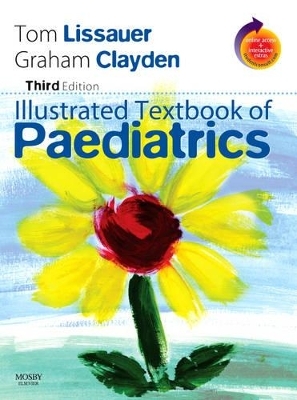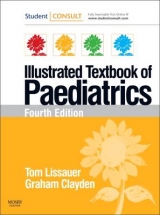
Illustrated Textbook of Paediatrics
Seiten
2007
|
3rd Revised edition
Mosby
978-0-7234-3397-2 (ISBN)
Mosby
978-0-7234-3397-2 (ISBN)
- Titel ist leider vergriffen;
keine Neuauflage - Artikel merken
Zu diesem Artikel existiert eine Nachauflage
Suitable for medical students for their course in clinical paediatrics, this textbook of paediatrics helps trainee paediatricians prepare for the MRCPCH, and general practitioners prepare for the DCH. It places emphasis on the core fundamentals of paediatrics practice throughout the world.
This is a concise, colourfully illustrated and highly informative textbook of paediatrics. Written primarily for medical students for their course in clinical paediatrics (6-10 weeks in duration in the UK and worldwide), the book has found a wider audience among nurses, trainee paediatricians preparing for the MRCPCH, and general practitioners preparing for the DCH. Throughout, there is an emphasis on the core fundamentals of paediatrics practice throughout the world, which has contributed to its success in Europe, Asia, Australia and the Middle East. Why is the book so appealing? There are three main reasons: the combined systems/symptoms approach, which is particularly suited to the study of children's illnesses; the amount of detail covered in a very succinct style, making it appropriate for a wide range of students; and, the appealing way in which it is written and presented. The following quotes from student/trainee reviewers explain these reasons even more clearly. The book combines a traditional, systems-based approach with a symptoms-based approach, which is particularly appropriate to paediatrics.
To quote from one student's review: 'Having topics such as 'acute abdominal pain', headache' or 'the unconscious child' at the start of a separate section within a chapter, with differentials, aetiologies, clinical signs and investigations, is very useful in getting students to constantly think of the way in which children would present to them in a medical setting. This helps them to design a logical way of thinking about specific presentations, as they are faced in their clinical career'. As mentioned above, the book has found a wide readership - from nurses and medical students to trainees in paediatrics. To quote from one trainee's review: 'It is so refreshing to come across a medical textbook that manages to convey key points, provide additional detail at a more advanced level, and make the acquisition of knowledge a pleasurable experience through interesting and varied presentation...This book is remarkable in that it manages to pitch itself at both an undergraduate level and at that of a paediatric SHO coming up to membership exams (especially clinical). Each time I have re-read it, I have taken in more information than on the previous occasion'.
The varied style of the book and the use of many different types of illustrations all contribute to its success. To quote from another review: 'The way the book is presented is integral to its success. For those...who tire easily reading textbooks, the bright and varied layout is extremely important. There is a good balance of photos, tables, flowcharts and text - and ...many people need variety in order to be able to assimilate and retain information effectively'.
This is a concise, colourfully illustrated and highly informative textbook of paediatrics. Written primarily for medical students for their course in clinical paediatrics (6-10 weeks in duration in the UK and worldwide), the book has found a wider audience among nurses, trainee paediatricians preparing for the MRCPCH, and general practitioners preparing for the DCH. Throughout, there is an emphasis on the core fundamentals of paediatrics practice throughout the world, which has contributed to its success in Europe, Asia, Australia and the Middle East. Why is the book so appealing? There are three main reasons: the combined systems/symptoms approach, which is particularly suited to the study of children's illnesses; the amount of detail covered in a very succinct style, making it appropriate for a wide range of students; and, the appealing way in which it is written and presented. The following quotes from student/trainee reviewers explain these reasons even more clearly. The book combines a traditional, systems-based approach with a symptoms-based approach, which is particularly appropriate to paediatrics.
To quote from one student's review: 'Having topics such as 'acute abdominal pain', headache' or 'the unconscious child' at the start of a separate section within a chapter, with differentials, aetiologies, clinical signs and investigations, is very useful in getting students to constantly think of the way in which children would present to them in a medical setting. This helps them to design a logical way of thinking about specific presentations, as they are faced in their clinical career'. As mentioned above, the book has found a wide readership - from nurses and medical students to trainees in paediatrics. To quote from one trainee's review: 'It is so refreshing to come across a medical textbook that manages to convey key points, provide additional detail at a more advanced level, and make the acquisition of knowledge a pleasurable experience through interesting and varied presentation...This book is remarkable in that it manages to pitch itself at both an undergraduate level and at that of a paediatric SHO coming up to membership exams (especially clinical). Each time I have re-read it, I have taken in more information than on the previous occasion'.
The varied style of the book and the use of many different types of illustrations all contribute to its success. To quote from another review: 'The way the book is presented is integral to its success. For those...who tire easily reading textbooks, the bright and varied layout is extremely important. There is a good balance of photos, tables, flowcharts and text - and ...many people need variety in order to be able to assimilate and retain information effectively'.
1. The child in society 2.History and examination 3.Normal child development, hearing and vision 4. Developmental problems and the child with special needs 5.Care of the sick child 6.Paediatric emergencies 7.Environment 8.Genetics 9.Perinatal medicine 10.Neonatal medicine 11.Growth and puberty 12.Nutrition 13.Gastroenterology 14.Infection 15.Allergy and immunity 16. Respiratory disorders 17.Cardiac disorders 18.Kidney and urinary tract 19.Genitalia 20.Liver disorders 21.Malignant disease 22.Haematological disorders 23.Emotions and behaviour 24.Skin 25.Endocrine and metabolic disorders 26.Bones, joints and rheumatic disorders 27.Neurological disorders 28. Adolescent medicine
| Erscheint lt. Verlag | 27.6.2007 |
|---|---|
| Zusatzinfo | Approx. 700 illustrations (650 in full color) |
| Verlagsort | London |
| Sprache | englisch |
| Maße | 280 x 216 mm |
| Gewicht | 1243 g |
| Themenwelt | Medizin / Pharmazie ► Medizinische Fachgebiete ► Pädiatrie |
| Studium ► 2. Studienabschnitt (Klinik) ► Kinderheilkunde | |
| ISBN-10 | 0-7234-3397-6 / 0723433976 |
| ISBN-13 | 978-0-7234-3397-2 / 9780723433972 |
| Zustand | Neuware |
| Haben Sie eine Frage zum Produkt? |
Mehr entdecken
aus dem Bereich
aus dem Bereich

